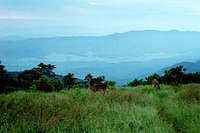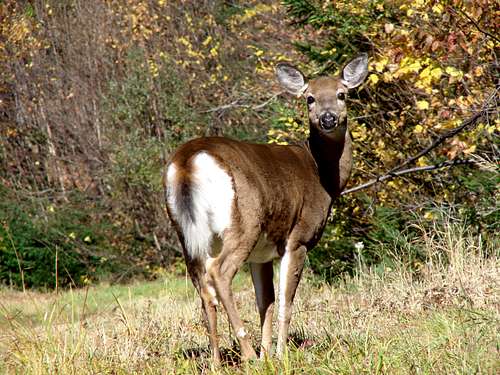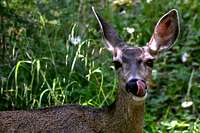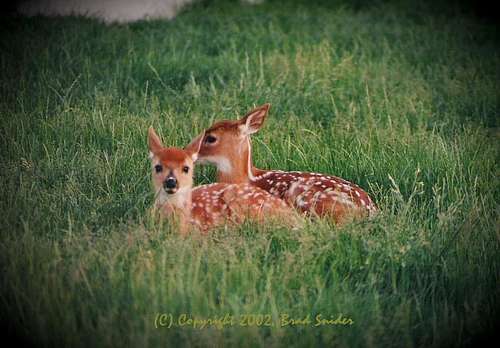Layout designed for best viewing on a "1024 x 768" screen.
![Yosemite Deer]() A Large Whitetail Buck jumping a fence, kolbi2112 photo.
A Large Whitetail Buck jumping a fence, kolbi2112 photo.![Whitetail deer can often be...]() Whitetail Deer Feeding, iamaclimber photo.
Whitetail Deer Feeding, iamaclimber photo.Introduction:
![Deer]() Whitetail Doe, Jack Cunningham photo.
Whitetail Doe, Jack Cunningham photo.
The Whitetail Deer is the most widespread deer in the world. Scientists recognize 30 whitetail subspecies in North and Central America, and another 8 in South America. North America's whitetail population is estimated at 20-25 million animals. If deer have enough food, water and shelter, their population can grow very quickly.
Surely almost everyone who gets out of the city has seen a Whitetail Deer. Unlike their Mule Deer cousins who sneak out of the area without being seen a Whitetail Deer will wait until the last moment then explode out of hiding. They rely on shock and pandemonium to escape from a predator or human being.
Please attach your Quality Whitetail Deer photos to this page.Whitetail Deer:
![Deer around the summit.]() Whitetail Doe, kennyg432000 photo.
Whitetail Doe, kennyg432000 photo.![Good eats?]() Whitetail Doe, rayray photo.
Whitetail Doe, rayray photo.
The Whitetail Deer is an herbivore or plant eater. It has a set pattern of trails that it follows to and from its feeding areas. The diet changes as different foods become available. Generally, Whitetail Deer will feed in the early morning hours and then again in the late afternoon to early evening.
The Whitetail Deer is able to regurgitate its food from its stomach that is divided into four parts. This is called chewing its cud. Cows, bison, bighorn sheep, goats, llamas, camels and giraffes are also ruminants.
When a Whitetail Deer is alarmed, it may stomp its hooves and snort to warn other deer. It may also "flag" or raise its tail and show its white underside. When a mother deer, called a Doe, is running, this white underside can help her fawns follow her. White-tailed deer are very good runners. They can run at speeds of up to 30 mile an hour. They are also good leapers and swimmers.
Whitetail deer are not especially vocal, although young fawns bleat on occasion. Injured deer utter a startlingly loud "blatt" or bawl. Whistles or snorts of disturbed whitetails are the most commonly heard sounds.
Like mule deer, Whitetail bucks grow a new set of antlers every year, shedding the old ones after the rut (breeding season) is over. Whitetail antlers are comprised of one main beam per antler; in mature bucks, each beam may have three or more tines sprouting from the beam.
Life Cycle:
![Telling A Secret]() Whitetail Fawns, Brad Snider photo.
Whitetail Fawns, Brad Snider photo.
Bucks begin rutting as early as September; this is called the pre-rut, and as it gets closer to November they become entirely preoccupied with mating. They do not guard harems (as with elk) but rather fight each other individually, clashing antlers to gain the right to breed a particular female.
The full fledged breeding season takes place in November and December in the Rocky Mountains. Most Whitetail Deer (particularly bucks) mate in their second year, although some females occasionally mate as young as seven months. After 6 months of pregnancy a doe gives birth to 1 to 3 fawns. The fawns can walk at birth and their reddish-brown fur with white spots helps them blend into their environment.
The Whitetail Deer lives an average of 11 to 12 years if they can avoid disease, predators, human hunters and being hit by automobiles. They are about 6 feet long and stand 3 to 4 feet high. A buck can weigh as much as 300 pounds.
Distribution:
The Whitetail Deer can be found in southern Canada and most of the United States, except for the Southwest, Alaska and Hawaii.
A deer's home range is usually less then 1 square mile. Whitetail Deer are able to survive in a variety of habitats, from the National Forests of the Rocky Mountains to the slopes and farm lands that surround them.
Natural Predators and Risks:
![The cycle of life]() Deer Carcass, dmiki photo.
Deer Carcass, dmiki photo.
Whitetail Deer have good eyesight and acute hearing, but depend mainly on their sense of smell to detect danger and their ability to run and bound quickly through dense vegetation to escape danger.
Whitetail Deer are preyed on by large predators such wolves, mountain lions, bears and coyotes. Predators play a critical role in keeping the population under control. Because there are not many natural predators, deer populations can sometimes grow too large for their environment and deer can starve to death. Winter is a dangerous time for deer. Their long narrow legs and pointed hooves make it hard for them to move around in the snow and ice and it is easier for predators to catch them.
Disease and parasites like lice, mites and roundworms can weaken or kill deer. Young deer and old deer often get sick and die, especially in the winter.
Threats from Mankind:
Whitetail Deer are destructive to crops, vegetable gardens, fruit trees, and ornamental plants where their ranges overlap with human habitation. When their numbers become too high, whitetail deer can cause serious damage to forest vegetation through overbrowsing.
Whitetail Deer are important as vectors disease because they serve as hosts to the ticks which carry the bacteria responsible Lyme disease. This has become an increasingly common disease in certain parts of the United States, especially the northeastern states.
Conservation:
Whitetail Deer are extremely common throughout their ranges and are the most numerous of the large North American mammals. Although their populations were decimated to the point of extinction in many areas at the turn of the century (due to overhunting), they have recently reached their highest numbers due to the improvement of their habitat by the cutting of climax forests, providing them with a greater amount of brush and shrubs on which to forage.
The Future:
The Whitetail Deer is expanding its range. Increased management will be necessary to prevent disease for having widespread effects on the Whitetail Deer.









Comments
Post a Comment